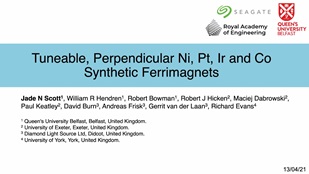
Tuneable, Perpendicular Ni, Pt, Ir and Co Synthetic Ferrimagnets
J.N Scott, W.R Hendren, R. Bowman, R,J Hicken, M. Dabrowski, D.M. Burn, A. Frisk, G. van der Laan and A. N’Diaye
Magnetism and Magnetic Materials Online April 2021
Synthetic ferrimagnets (SFM) two ferromagnetic layers with different magnetic moments, exchange-coupled via the RKKY interaction across a non-magnetic spacer layer, are of particular interest as a feasible media for all optical magnetic switching. Design of the magnetic properties of these SFM structures requires knowledge and control of the magnetisation, M(T), and anisotropy, K(T), of each ferromagnetic layer, and the strength of the exchange coupling between them, Jij(T).
We have shown it is possible to engineer the magnetic properties of series of compensating Ni3Pt/Ir/Co SFMs, fabricated by magnetron sputtering and exhibiting perpendicular magnetic anisotropy. The tuneability of this structure (through variation of the Ni3Pt deposition temperature and the thickness of each layer) provides an ideal system with which to investigate the effect of M(T), K(T) and Jij(T) on reversal mechanisms within SFMs, with the additional benefit of distinct magnetic species allowing for element and layer specific characterisation.
Initial pump/probe experiments reveal that it is possible to switch these SFMs by application of optical laser pulses under only a small applied field. Full optical switching requires stronger antiferromagnetic exchange coupling than can currently be achieved in Ni3Pt/Ir/Co SFMs, as a result of the elevated deposition temperatures necessary for PMA in Ni3Pt. A possible solution is to replace the Ni3Pt layer with a Ni/Pt multilayer, in which PMA can be achieved by careful choice of layer thickness. This gives scope for improving the exchange coupling by removing the cooling step during deposition, while also maintaining element specificity and tuneability of the magnetic properties.

Figure 1: Remanent magnetisation as a function of temperature of a Ni3Pt(7nm)/Ir(0.4nm)/Co(1nm) SFM with arrows depicting this sample’s layer alignment, Co (green) and Ni3Pt (red, solid), and noting the positions of the magnetisation compensation point, Tcomp and T-MR, the onset temperature of negative remanent magnetisation. The multilayer sample, 4x[Ni(0.6nm)/Pt(0.4nm)] /Ni(0.6nm)/Ir(0.4nm)/Co(1nm), shows the same temperature dependent behaviour.
Figure 2: Element specific XMCD hysteresis loops of a Ni3Pt(8.5nm)/Ir(0.5nm)/Co(1nm) SFM recorded at temperatures T < T-MR (~200K), T ~ TMR (~220K) and T > T-MR (~250K), with Co (blue) loops shown on top and Ni (red) shown below. Arrows show the direction of the field sweep.
[1] S. Mangin et al, Nature Materials 13, 286 (2014)
[2] R. F. L. Evans et al, Appl. Phys. Lett. 104, 082410 (2014)